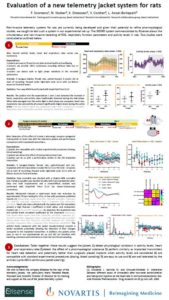F. Scorrano1, N. Stuber2, K. Dreessen2, V. Cordier2, L. Ansel-Bollepalli2
¹ Novartis International AG – Training and innovation group, Basel, Switzerland
² Novartis International AG – Research collaborations group, Basel, Switzerland
15th FELASA Congress, 2022
Abstract
Non-invasive telemetry systems are currently being developed and given their potential to refine pharmacological studies, we sought to test such a system (telemetry jackets) in our experimental set up.
Two studies were conducted. First, the activity levels, heart and respiratory rates were recorded across one nyctemera to establish how well physiological variations are detected. Secondly, the same parameters were recorded over 48hrs in rats surgically implanted with a classic transmitter. On recording days, the rats were treated with saline or 5 mg/kg of metoprolol to see how practical the jackets are in a standard pharmacology study context and how their performance compares with that of a standard surgically implanted transmitter.
The jackets detect significant variations in activity levels, heart and respiratory rates across the nyctemera, with values increasing during the dark phase (ANOVA analyses; Heart rate: F=22.33, p<0.001; Respiratory rate: F=8.77, p=0.0033; Activity levels: F=10.44, p=0.0015). Within 15 min of metoprolol injection, the heart rate decreases by approximately 80 beats per minute, and remains lower than in saline-injected rats for approximately 1.5 hrs (Mixed-effect analysis: Time x Treatment F(46, 190) = 2.379, p<0.0001). In metoprolol-injected animals, the Pearson r correlation coefficient between the heart rates measured with the jackets and the implants is of 0.907.
Taken together, these results suggest the jackets 1) detect physiological variations in activity levels, heart and respiratory rates 2) are compatible with standard experimental procedures and 3) perform similarly as implanted transmitters for heart rate detection.

